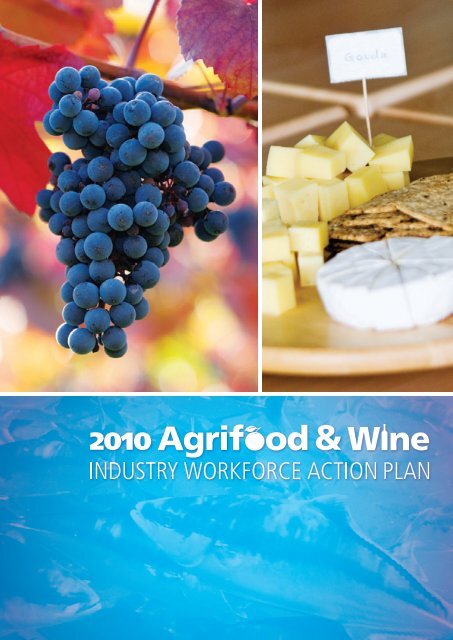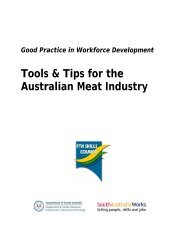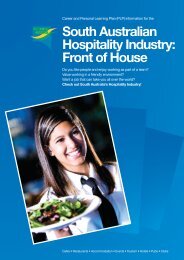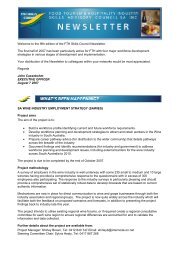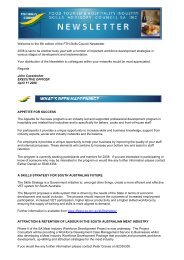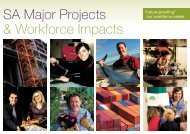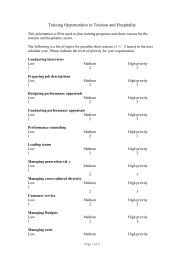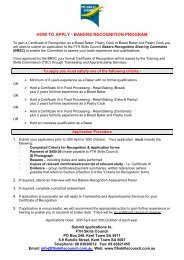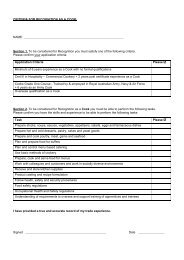download here - FTH Skills Council
download here - FTH Skills Council
download here - FTH Skills Council
You also want an ePaper? Increase the reach of your titles
YUMPU automatically turns print PDFs into web optimized ePapers that Google loves.
Introduction from the Chairs of the Primary Industries <strong>Skills</strong> <strong>Council</strong> &<br />
the Food, Tourism, & Hospitality Industry <strong>Skills</strong> Advisory <strong>Council</strong><br />
The Agrifood and Wine Industries in South Australia are major<br />
contributors to the State’s economy and hold pre-eminent positions<br />
in the State’s rural and regional areas.<br />
The task is not easy as t<strong>here</strong> is increasing competition for labour<br />
and without firm action, opportunities to increase food production<br />
and maintain a viable regional population base will not be realised.<br />
The industries are also significant national players in a number of<br />
sectors including Wine, Seafood, Beef and Grains, and include the<br />
nation’s leading food processing companies.<br />
The Agrifood and Wine industries have been subject to a range of<br />
challenges including a rapidly ageing workforce, declining regional<br />
workforces, higher levels of competition from global food groups,<br />
cycles of drought and plenty, ongoing water security issues and<br />
climate change.<br />
Coupled with these is a trend towards larger corporate structures<br />
that can better compete in a rapidly changing global marketplace.<br />
A key factor in sustaining the industries and positioning them for<br />
growth is the ability to attract and retain workers with the right skills<br />
and abilities to adapt to rapidly changing industries. With intensive<br />
production systems, smart technologies and the emergence of a<br />
value chain approach, the industries need an integrated response<br />
to sourcing the labour and skills they need.<br />
The Agrifood and Wine Industries recognised that meeting these<br />
challenges requires a collaborative approach between relevant<br />
Government agencies and the Industry <strong>Skills</strong> Boards. The result of<br />
this collaboration has been the development of the Agrifood and<br />
Wine Industry Workforce Action Plan.<br />
The Plan is a strategic document that aims to integrate Government<br />
and industry resources to address the industries’ attraction and<br />
retention issues. Importantly, it provides the industries with a firm<br />
action plan that will provide new skills for new jobs.<br />
We believe that the Plan offers real hope for the industries and the<br />
many regional areas that depend on strong and productive Agrifood<br />
and Wine sectors.<br />
Nick Papazahariakis - Chairman<br />
Food, Tourism & Hospitality Industry <strong>Skills</strong> Advisory <strong>Council</strong><br />
Milan Rapp - Chairman<br />
Primary Industries <strong>Skills</strong> <strong>Council</strong>
Challenges facing the SA Agrifood<br />
and Wine Industries<br />
The diverse and dispersed nature of the Agrifood and<br />
Wine workforces present crucial challenges for the<br />
industries in moving forward:<br />
The need for industries and Government to collaborate in<br />
workforce planning and development<br />
Greater flexibility and responsiveness of the training system<br />
to industry needs<br />
Attraction and retention of skilled and adaptable workers<br />
in all industry sectors<br />
Better integration of employment and skills demands with<br />
industry development<br />
Greater links between innovation and new technological<br />
developments with business practices, including skill development<br />
The impact of the global market on the agrifood and wine sectors<br />
Remote and regional locations of the industries and the impact<br />
on labour force supply<br />
Use and availability of natural resources and the impact on the<br />
sustainability of the industries<br />
Increasing the productivity of the workforce<br />
Responding to the challenges<br />
The strategies and actions in this plan focus on:<br />
Better workforce planning and development to secure a skilled<br />
labour force<br />
Development of innovative attraction and retention strategies<br />
Improved human resource capabilities to attract and retain labour<br />
Improved access to education, training and skills development<br />
opportunities<br />
Better government, industry and regional coordination to<br />
deliver on skill needs<br />
Promoting and supporting best practices in workforce<br />
planning and development<br />
Strengthened links between enterprises and agrifood and<br />
wine research resulting in more direct enterprise benefit<br />
Industry involvement<br />
The Agrifood and Wine Industry Workforce Action Plan (Agrifood<br />
and Wine IWAP) was developed through the collaborative efforts of<br />
the Primary Industries <strong>Skills</strong> <strong>Council</strong>, Food Tourism and Hospitality<br />
Industry <strong>Skills</strong> Advisory <strong>Council</strong>, key South Australian Government<br />
agencies, the Premier’s Food <strong>Council</strong> and the South Australian<br />
Wine Industry <strong>Council</strong>. Extensive consultation was undertaken<br />
with industry groups through face to face interviews, focus groups,<br />
presentations to industry groups and a series of forums, and<br />
general information sessions. The information acquired from these<br />
sources has informed, shaped and steered the development of the<br />
strategies and actions, producing an action plan that is reflective<br />
of the diverse challenges facing the industry in moving forward.<br />
W<strong>here</strong> to from <strong>here</strong>?<br />
Consistent with the recommendations of Professor Fearne<br />
Adelaide’s Thinker in Residence, the Agrifood and Wine IWAP<br />
will be implemented and monitored through the SA Food Plan<br />
and SA Wine Partnership. An Agrifood and Wine Alliance (the<br />
Alliance) of high level industry and government representatives<br />
will oversee the implementation of the strategies and actions<br />
of the Agrifood and Wine IWAP. The Alliance will include<br />
representatives from the Premier’s Food <strong>Council</strong>, Wine <strong>Council</strong>,<br />
Primary Industries <strong>Skills</strong> <strong>Council</strong>, Food Tourism and Hospitality<br />
Industry <strong>Skills</strong> Advisory <strong>Council</strong> and industry more broadly.<br />
The Agrifood and Wine Alliance will also collaborate with key<br />
consultative bodies and SA Government agencies as needed.<br />
For further information visit:<br />
Primary Industries and Resources SA<br />
(PIRSA) - www.safoodcentre.com.au<br />
Department of Further Education, Employment, Science<br />
and Technology (DFEEST) - www.workforceinfoservice.sa.gov.au<br />
Food, Tourism and Hospitality Industry <strong>Skills</strong><br />
Advisory <strong>Council</strong> - www.fthskillscouncil.com.au<br />
Primary Industries <strong>Skills</strong> <strong>Council</strong> - www.pisc.org.au
Strategies &<br />
Recommended<br />
Actions<br />
Strategy 1:<br />
Promote and support the application of workforce<br />
planning and development best practices across<br />
all sectors of the Agrifood and Wine industries in<br />
South Australia.<br />
Industry and Government are increasingly recognising the need<br />
to promote workforce planning and development capabilities<br />
more widely across industry sectors to assist enterprises to secure<br />
the workforce they need, and benefit from the knowledge gained<br />
through recent workforce development initiatives. Over time, this<br />
is expected to result in the increased adoption of good workforce<br />
planning practices.<br />
Recommended Actions<br />
• Identify and consolidate existing workforce planning and<br />
development best practices.<br />
• Promote the use of these best practices and related materials and<br />
tools to industry and government through a promotional campaign.<br />
• Promote and facilitate the use of current initiatives that provide<br />
targeted support for long term workforce and business planning<br />
with small and medium sized enterprises.<br />
• Promote the concept of employer of choice through targeted case<br />
studies and awards for best practice for workforce planning.<br />
• Develop industry pathways programs with an employer of choice<br />
focus that facilitate and support the increased flow of new workers<br />
into the industry sector.
Strategy 2:<br />
Improve access to the range of education and<br />
skills development opportunities, and promote<br />
the benefits across industry.<br />
Strategy 3:<br />
Strengthen strategic alliances between industry<br />
and government to optimise the use of resources<br />
that deliver workforce development solutions.<br />
An industry’s training and up-skilling needs must be targeted,<br />
timely and provided through flexible delivery modes to better meet<br />
their needs. Over time, this will result in enterprises and educational<br />
institutions working in partnership to provide workforce solutions<br />
that align with enterprise skill needs and support skills mobility<br />
across the industry.<br />
Industry, government and workforce development agents need<br />
to be able to develop workforce solutions that are more tailored<br />
and targeted to industry needs through a more integrated service<br />
approach. This will result in a more effective use of available<br />
resources and provide more direct help to enterprises across<br />
the Agrifood and Wine industries.<br />
Recommended Actions<br />
• Increase access to relevant industry career advice and skills<br />
recognition so workers have access to opportunities, leading to<br />
sustainable long term employment through appropriate education<br />
and training.<br />
• Establish skill development partnerships between industry<br />
and registered training organisations to achieve improved<br />
organisational learning across all sectors.<br />
• Improve the promotion of existing Government supported<br />
programs and initiatives to increase the uptake of training<br />
• Support the development of a collaborative relationship between<br />
the higher education sector and industry to better align courses<br />
with employment and skill needs.<br />
Recommended Actions<br />
• Establish a more holistic and integrated approach by industry<br />
and government in South Australian regions between Industry<br />
Development Boards, Industry <strong>Skills</strong> Boards and related industry<br />
structures that identifies the workforce development needs of<br />
Agrifood and Wine industry sectors, such as infrastructure and<br />
resource requirements.<br />
• Develop coordinated regional networks that include Regional, State<br />
and Commonwealth workforce and economic development agencies.<br />
• Facilitate greater collaboration between Government, industry,<br />
employment and workforce development providers to identify<br />
workforce needs, and develop, implement and monitor workforce<br />
development solutions.<br />
• Identify existing government programs that support workforce<br />
planning and development, and improve coordination of program<br />
delivery across the regions.<br />
• Implement Professor Andrew Fearnes’ recommendations<br />
across the Agrifood and Wine Industries as they relate to<br />
workforce development.<br />
• Identify and communicate the infrastructure issues that constrain<br />
the industry’s ability to attract and retain its workforce to the<br />
relevant agencies.
Strategy 4:<br />
Strengthen the links between research and businesses<br />
to foster clear communication to better focus research<br />
endeavours and successful adoption and diffusion of<br />
research findings.<br />
The ability to both generate and apply new knowledge and<br />
technologies to enhance productivity in the workplace will depend<br />
on the skills of the workforce. In order to equip the workforce with<br />
the skills and knowledge to do this, t<strong>here</strong> is a need to accelerate the<br />
transfer of new knowledge and technologies by bringing the research,<br />
business and training communities together. This will improve the<br />
industry’s productivity and increase its competitiveness in the<br />
global market place.<br />
Recommended Actions<br />
• Support continuous adoption of innovation and technological<br />
solutions along the value chain through industry clusters.<br />
• Establish forums between research communities and industry to<br />
facilitate collaboration, guide research priorities, and ensure rapid<br />
transfer and take-up of findings.<br />
Strategy 5:<br />
Continue to develop and implement a range of<br />
innovative attraction and retention strategies and<br />
workforce practices.<br />
The current Agrifood and Wine industry workforces are under<br />
competitive pressure to attract and retain a greater proportion<br />
of skilled workers. In order to meet future workforce and production<br />
requirements, industry needs to be encouraged to consider alternative<br />
workforce options and develop strategies that facilitate the inclusion<br />
of population groups not currently engaged in employment or fully<br />
employed. This will result in an increase in the breadth, depth and<br />
use of skills in the workforce.<br />
Recommended Actions<br />
• Develop and promote Agrifood and Wine career and training<br />
pathways to potential and existing employees through existing<br />
networks including educational institutions and career<br />
development centres.<br />
• Strengthen connections between case management<br />
employment services and the Agrifood and Wine industries.<br />
• Identify and promote innovative workforce planning and<br />
development practices that engage and retain skilled workers.<br />
• Identify and promote programs that engage and support<br />
workers from non-traditional groups including skilled migrants,<br />
underemployed, Indigenous people, women and people<br />
returning to work.
Strategy 6:<br />
Determine current and projected industry workforce<br />
requirements for specific skills and seasonal labour<br />
and develop a range of responses to meet these<br />
requirements.<br />
The industries periodically face a mismatch of labour supply<br />
and demand and t<strong>here</strong> is often insufficient supply of labour to<br />
meet seasonal demands. In an effort to address this, the Agrifood<br />
and Wine Industries will need to identify and quantify these skills<br />
and labour gaps and monitor them through ongoing research.<br />
This will better inform service providers of actual skill and labour<br />
needs and result in more timely and relevant responses in line<br />
with those requirements.<br />
Recommended Actions<br />
• Research and define specific skills and seasonal labour<br />
requirements across the sectors and regions, with support<br />
from existing Government and industry programs.<br />
• Disseminate research results to the Agrifood and Wine Industries,<br />
Government and registered training organisations to enable them<br />
to develop actions to address the labour and skill gaps.<br />
• Continue to promote the use of all appropriate visa arrangements<br />
including Government and industry sponsored migration and<br />
working holiday arrangements such as Harvest Trail and Harvest<br />
Guide, to target specific labour requirements in regional locations.<br />
Strategy 7:<br />
In collaboration with stakeholders, develop and<br />
implement tailored regional initiatives to attract<br />
and retain people to the workforce.<br />
The rural and regional location of many of the industry<br />
sectors creates particular problems for attracting, developing<br />
and retaining a workforce with the skills needed to meet industry<br />
requirements. To overcome these challenges, stakeholders must<br />
adopt a coordinated and collaborative approach to developing and<br />
implementing strategies for rural and regional areas, which include<br />
the promotion of the benefits of the Agrifood and Wine sectors and<br />
lifestyle. Over time, this would result in effective and integrated<br />
attraction and retention programs that promote the employment<br />
opportunities and lifestyle benefits of rural and regional locations,<br />
and create a system that assists people to navigate their<br />
employment and lifestlye choices.<br />
Recommended Actions<br />
• Develop a campaign that promotes the industries as preferred<br />
workplaces and the benefits of rural and regional living.<br />
• Communicate the outcomes of successful programs and<br />
projects to inform and direct future policy development.<br />
• Coordinate employment and skill development services<br />
within regions to maximise the value of regional resources.
The South Australian Agrifood and Wine Industries<br />
The Agrifood and Wine industries are composed of a wide array of<br />
industry sectors including horticulture, agriculture, viticulture and wine<br />
production, dairy, seafood and food processing. South Australia has<br />
an international reputation for quality agricultural and food products,<br />
including seafood, meat, horticulture and dairy. The food sector is one<br />
of South Australia’s largest industries, with growing exports to China,<br />
India, the United States and South-East Asia.<br />
In providing these products, the Agrifood and wine industries<br />
employed around 50, 000 people in 2006, accounting for almost<br />
8 per cent of all employment in South Australia. The industry is the<br />
largest employer in all regional areas, significantly impacting on<br />
regional economies and employment in other industries. The majority<br />
of the workforce is engaged in the production of foodstuffs – around<br />
30, 000 people or 60 per cent of the total Agrifood and Wine industry<br />
workforces in 2006. The food processing and manufacturing sector<br />
accounts for around 37 per cent of total employment (just over<br />
18, 000 people).<br />
Agribusiness and the rural sector are becoming increasingly<br />
sophisticated, requiring a highly skilled and educated workforce<br />
from a range of disciplines, with the skill sets to adopt and use new<br />
technologies, techniques and practices. The global environment<br />
and climate change pressures may also require the application<br />
of research and development outcomes that are supported by<br />
sustainable practices in business management, leadership, value chain<br />
management and workforce development.<br />
Key workforce highlights are:<br />
The need for higher level knowledge and skills in the Agrifood<br />
and Wine industries<br />
The older age profile of the workforce in comparison to the<br />
general population.<br />
High levels of employment in Agrifood and Wine industries<br />
across regional SA.<br />
Although the prospects for South Australia’s Agrifood and Wine<br />
sectors are positive, the industries are faced with a combination of<br />
factors affecting productivity, profitability and capacity to attract,<br />
retain and develop their staff. These factors include natural resource<br />
issues; infrastructure development; climate change; value of the<br />
Australian dollar; global trade; and an ageing workforce.<br />
The nature of farming, food production and food processing is rapidly<br />
changing. In some areas, family owned and operated businesses are<br />
giving way to corporate structures that rely on different economies of<br />
scale and intensive use of plant and human capital and infrastructure.<br />
This increasing mechanisation and intensification of farming systems<br />
is driving significant changes in the workforce.<br />
Employers are also faced with new challenges, requiring human<br />
resource skills, an understanding of the changing competitive labour<br />
market and an understanding of new attraction and retention<br />
strategies. A more strategic approach is required across regional<br />
agencies to understand the labour market dynamics and ensure<br />
connections are developed between employers, potential employees<br />
and providers of skill development services.


